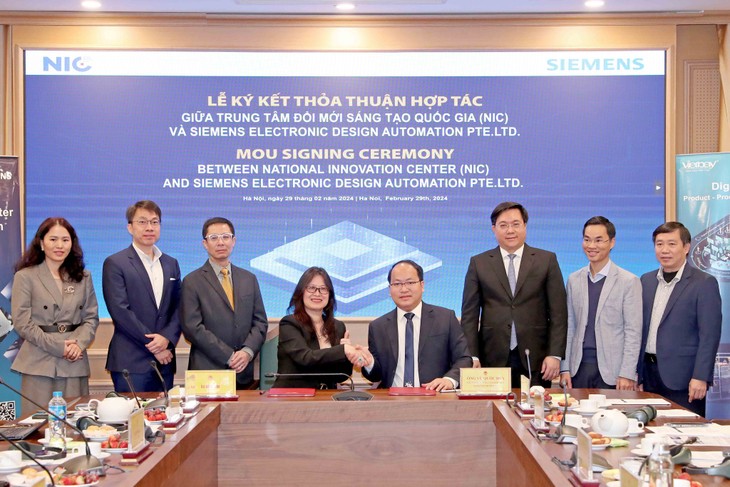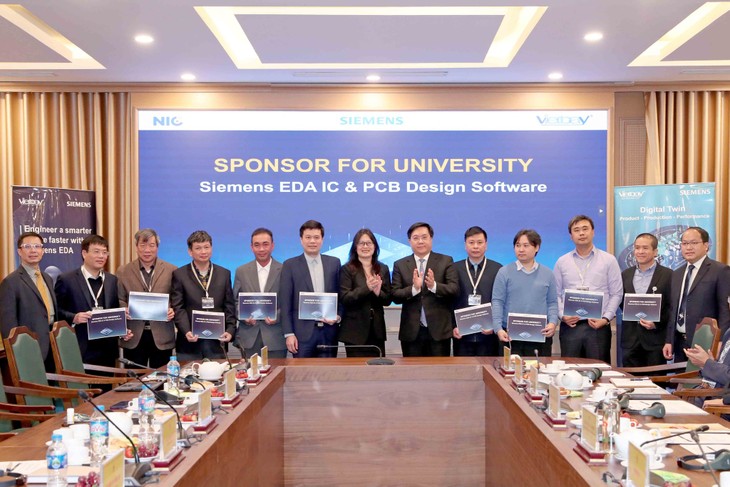(VOVWORLD) - What should Vietnam do to have high-quality human resources to serve the semiconductor industry which the Vietnamese Government has high expectations for? A project “Developing human resources in the semiconductor industry until 2030, with a vision to 2045″ is being urgently researched and will soon be submitted to the Government for approval. By 2030 Vietnam intends to train 50,000 engineers to serve the industry at all stages of the value chain.
 Nina Lin, Siemens EDA’s Vice President and General Manager for Taiwan and South Asia region, pledges Siemens EDA will sponsor Vietnam with Siemens’ most advanced chip design software and circuit boards. (Photo: NIC) Nina Lin, Siemens EDA’s Vice President and General Manager for Taiwan and South Asia region, pledges Siemens EDA will sponsor Vietnam with Siemens’ most advanced chip design software and circuit boards. (Photo: NIC)
|
Vietnam aims to become an important link in the global semiconductor industry value chain by 2045, with a team of engineers and experts capable of meeting the development requirements of Vietnam's semiconductor industry in both quality and quantity.
One way to realize the plan is to attract the world's leading technology corporations to invest in Vietnam’s semiconductor industry ecosystem and help it develop high-quality human resources.
Nguyen Quang Lich, head of the Engineering and Technology Faculty of Hue University, said on the sidelines of a recent conference in Hanoi on developing human resources for semiconductor IC design that it’ll be difficult for Vietnamese universities to do the technology training, especially for high-tech like chips and semiconductors, without support from corporations.
“Once we have students and teachers, technical support like Siemens’ algorithmic design software will be very useful. And cooperation between businesses and schools is imperative for high-tech development," said Lich.
Cooperating with German technology company Siemens Electronic Design Automation (Siemens EDA, part of the Siemens Group) is a prime example of the kind of cooperation Vietnam needs.
Last week Siemens EDA signed a cooperation agreement with the National Innovation Center (NIC) to develop the semiconductor ecosystem in Vietnam, to provide its advanced chip and board design software to Vietnam, and to provide human resources training and development for semiconductor circuit design and development.
Dam Thi Hong Lan, CEO of Vietbay, Siemens EDA’s authorized partner in Vietnam, insisted that this cooperation is right and timely, just as the leaders of the Ministry of Planning and Investment and Siemens have discussed.
“The cooperation demonstrates Siemens’ readiness to help Vietnam train human resources and develop its semiconductor industry," said Lan.
Cooperating with Siemens EDA will help Vietnam set up microchip research and development centers and train high-quality human resources for the industry.
 NIC and Siemens EDA present the sponsored software to universities tasked with training human resources for Vietnam's semiconductor industry. (Photo: NIC) NIC and Siemens EDA present the sponsored software to universities tasked with training human resources for Vietnam's semiconductor industry. (Photo: NIC) |
Universities play a key role in creating qualified semiconductor engineers.
Nguyen Duc Minh, Vice Dean of the Electrical and Electronics Engineering School of Hanoi University of Science and Technology, said Vietnam's semiconductor engineers are close to world class, but there are not enough of them.
Hanoi University of Science and Technology trains only 50 students a year in circuit design and 80-100 students in microelectronics technology and Vietnam is hampered by a lack of industry standard facilities, equipment, and software, as well as funding for semiconductor chip testing.
The semiconductor chip industry requires advanced skills and qualifications, said Minh, adding that if students learn theory but aren’t able to build chips in school, that’s a big disadvantage.
“First, higher-quality teachers must be trained. Second, there needs to be more investment in infrastructure. We must have, at least, equipment for the students to practice on. And third, we need to develop open learning resources and e-learning materials to attract more students,” Minh noted.
Minh said that having Siemens EDA’s latest tools and chip and circuit design support will allow schools to access advanced technology faster and make human resource training programs more effective.
According to Minh, to develop high-quality human resources, Vietnam needs to train students properly. This means giving them the right knowledge and skills to meet business needs.
“To that end, we have a couple of proposals,” said Minh, “First, conduct a field survey to understand what skills the market needs and in what quantity. Training facilities can then design appropriate strategies to meet those needs. Second, obtain capital and other resources for the NIC from corporations like Siemens and Cadence.”
“The Hanoi University of Science and Technology has coordinated with the NIC to install and use IC design software for teaching. But we need to expand the model,” Minh added.
He said he believes students majoring in electronics and telecommunications at Hanoi University of Science and Technology and Ho Chi Minh City University of Technology and Polytechnic University can participate in the design stage at businesses around the world.